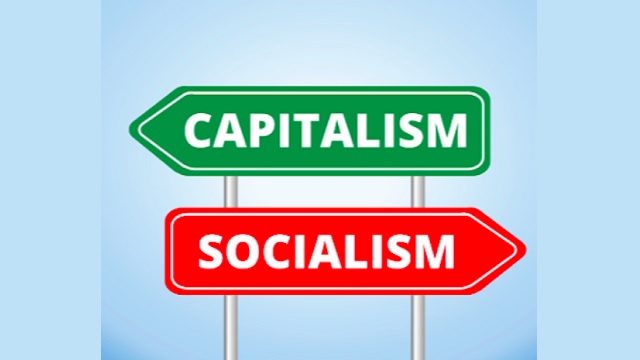PODCAST: Capitalism versus Socialism — Do You Know the Difference?

I originally wrote this piece in March 2019 and was pleasantly surprised by the flurry of questions I received regarding the differences between Capitalism and Socialism. High Schools simply do not teach the differences between these two important subjects, hence the interest in my article. So much so, I produced a free mini-poster to show the differences (click to DOWNLOAD). As these two opposing philosophies are key to the upcoming elections in November, I decided to rerun it herein and included it in my latest book, “BEFORE YOU VOTE: KNOW HOW YOUR GOVERNMENT WORKS.” Enjoy!
REFERENCE GUIDE
CAPITALISM SOCIALISM
| WHAT IS IT? | Socioeconomic system based on PRIVATE ownership of the means of production and operates for PROFIT.Encourages independence and the rights of the INDIVIDUAL over the group.The individual is allowed to try any endeavor, including the development, marketing and support of products and services for public consumption.
The individual is allowed to keep and enjoy the fruits of his/her labors. |
Socioeconomic system based on STATE ownership of the means of production; not driven by profit.Encourages state dependency and the rights of the GROUP over the individual.The state dictates what products and services are to be developed, and who shall produce them.
Each person works for the state, not individually, and receives compensation in the form of shared wealth and free services. A pseudo-Utopia. |
| ECONOMY | Free economy; based on private buyers and sellers.Competition flourishes and causes natural evolution of products and services through market demand (akin to Darwin’s “Natural Selection”).Consumers free to choose the products and services they want. | Economy is controlled by the state; little, if any, competition. Buyer has fewer choices to make. |
| CLASS STRUCTURE | 3 levels – Upper/Middle/Lower classes. Middle class powers economy through purchasing power. |
2 levels – State/Worker classes (aka, “Master/Slave”).No middle class, no economic engine, a redistribution of the wealth.Workers become wards of the state. |
| THE INDIVIDUAL | Independence encourages personal initiative and work ethic.More earning power, but individual assumes risk.Enjoys protection of Intellectual Property, e.g., patents, copyrights, trade secrets, etc.
Employment will experience ups and downs due to economic conditions. |
Discourages personal initiative (“everyone wins”). No Super Rich.Compensation is evenly distributed among workers.Earning power is limited. Individual assumes no risk.
Intellectual Property is owned by the state, not individual. Employment is guaranteed. |
| EFFECT ON GOVERNMENT | Personal independence requires freedom and equal rights in order to function.Requires less bureaucracy, smaller government.Flourishes under a Republic with democratically elected representatives. | Creates dependency on state; Requires more bureaucracy (larger government) through regulation as the state controls everything, including food, education, housing, communications, health care, energy, transportation, etc.Hinders rights and loss of liberty. Encourages autocratic rule. Less freedom. |
Click for MINI-POSTER.
Whereas Republicans tend to embrace Capitalism, Democrats tend to embrace Socialism, which helps explain the significant void between the two parties.
Keep the Faith!
RELATED ARTICLE: Advancing Free Trade Helps Ensure Economic Empowerment of Women
EDITORS NOTE: This Bryce is Right podcast is republished with permission. ©All rights reserved. All trademarks both marked and unmarked belong to their respective companies.


Leave a Reply
Want to join the discussion?Feel free to contribute!